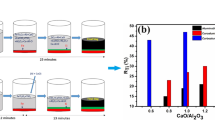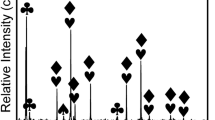Abstract
The significant fraction of manganese ores available across the globe is ferruginous with high gangue content. About 30% of these types of ores occur as fines (< 1 mm) and are dumped at the mines site, considering it as waste. Different methods have been tried to utilize these ores by 5–15% in the charge mix of submerged arc furnace by briquetting in roller press or by extrusion. A high amount of dust generation during charging limited its use. In this research work, a 30 kW DC extended arc plasma reactor is employed to extract FeMn from such a lean grade ore without performing any agglomeration. Flux is added targeting two different slag systems, CaO–Al2O3–SiO2 (CAS) and CaO–Al2O3–MgO–SiO2 (CAMS), to optimize the working temperature. FeMn20 alloy with a maximum manganese recovery of about 80% is achieved by following discard slag practice. The effect of basicity ratios on alloy yield and Mn recovery is studied; CaO/SiO2 ratio higher than 2.5 in charge composition shows a negative effect on Mn recovery. In the CAS system, less slag is generated than the charges adjusted to the CAMS system. However, in the CAMS system, the energy consumption is much lower than in the CAS system. The produced metal and slag are characterized by phase, composition, and microstructural analyses.
Graphical Abstract












Similar content being viewed by others
References
Seetharaman S (2014) Treatise on process metallurgy. Elsevier, Oxford. https://doi.org/10.1016/C2010-0-66691-0
Gasik MM (2013) Handbook of ferroalloys. Elsevier, Oxford. https://doi.org/10.1016/C2011-0-04204-7
Samuratov Ye, Baisanov AMT (2010) Complex processing of iron-manganese ore of central kazakhstan. In: Vartiainen A (ed) The twelfth international ferroalloys congress. Outotec Oyj, Finland, pp 517–520
Eissa M, Ghali S, Ahmed A, El-Faramawy H (2012) Optimum condition for smelting high carbon ferromanganese. Ironmak Steelmak 39:419–430. https://doi.org/10.1179/1743281211y.0000000062
Eissa M, El-Faramawy H, Ahmed A et al (2012) Parameters affecting the production of high carbon ferromanganese in closed submerged arc furnace. J Miner Mater Charact Eng 11:1–20. https://doi.org/10.4236/jmmce.2012.111001
Tripathy SK, Banerjee PK, Suresh N (2015) Effect of desliming on the magnetic separation of low-grade ferruginous manganese ore. Int J Miner Metall Mater 22:661–673. https://doi.org/10.1007/s12613-015-1120-0
Singh V, Ghosh TK, Ramamurthy Y, Tathavadkar V (2011) Beneficiation and agglomeration process to utilize low-grade ferruginous manganese ore fines. Int J Miner Process 99:84–86. https://doi.org/10.1016/j.minpro.2011.03.003
Rao GV, Mohapatra BK, Tripathy AK (1998) Enrichment of the manganese content by wet high intensity magnetic separation from Chikla manganese ore, India. Magn Electr Sep 9:69–82. https://doi.org/10.1155/1998/45169
Mishra PP, Mohapatra BK, Mahanta K (2009) Upgradation of low-grade siliceous manganese ore from Bonai-Keonjhar Belt, Orissa, India. J Miner Mater Charact Eng 08:47–56. https://doi.org/10.4236/jmmce.2009.81005
Zhang X, Tan X, Yi Y et al (2017) Recovery of manganese ore tailings by high-gradient magnetic separation and hydrometallurgical method. JOM 69:2352–2357. https://doi.org/10.1007/s11837-017-2521-5
Wu Y, Shi B, Ge W et al (2015) Magnetic separation and magnetic properties of low-grade manganese carbonate ore. JOM 67:361–368. https://doi.org/10.1007/s11837-014-1212-8
Mpho M, Samson B, Ayo A (2013) Evaluation of reduction roasting and magnetic separation for upgrading Mn/Fe ratio of fine ferromanganese. Int J Min Sci Technol 23:537–541. https://doi.org/10.1016/j.ijmst.2013.07.012
Kivinen V, Krogerus H, Daavittila J (2010) Upgrading of Mn/Fe ratio of low-grade manganese ore for ferromanganese production. In: Proceedings of the 12th international ferroalloys congress: sustainable future, pp 467–476
Liu B, Zhang Y, Lu M et al (2019) Extraction and separation of manganese and iron from ferruginous manganese ores: a review. Miner Eng 131:286–303. https://doi.org/10.1016/j.mineng.2018.11.016
El-Geassy AA, Nasr MI, Yousef MA et al (2003) Behaviour of manganese oxides during magnetising reduction of Baharia iron ore by CO–CO 2 gas mixture. Ironmak Steelmak 27:117–122. https://doi.org/10.1179/030192300677417
Gao Y, Olivas-Martinez M, Sohn HY et al (2012) Upgrading of low-grade manganese ore by selective reduction of iron oxide and magnetic separation. Metall Mater Trans B 43:1465–1475. https://doi.org/10.1007/s11663-012-9731-6
Nurjaman F, Amarela S, Noegroho A et al (2017) Beneficiation of two different low-grade Indonesian manganese ores to improve the Mn/Fe ratio. AIP Conf Proc. https://doi.org/10.1063/1.4978094
Yi L, Huang Z, Jiang T et al (2017) Carbothermic reduction of ferruginous manganese ore for Mn/Fe beneficiation: morphology evolution and separation characteristic. Minerals. https://doi.org/10.3390/min7090167
Gao L, Liu Z, Chu M et al (2019) Upgrading of low-grade manganese ore based on reduction roasting and magnetic separation technique. Sep Sci Technol (Philadelphia) 54:195–206. https://doi.org/10.1080/01496395.2018.1504795
Rath SS, Tripathy SK, Rao DS, Biswal SK (2018) Characterization and reduction roasting studies of an iron rich manganese ore. Trans Indian Inst Met 71:861–872. https://doi.org/10.1007/s12666-017-1218-3
Samal SK, Mishra B, Mishra SC (2020) Carboaluminothermic production of ferrotitanium from ilmenite through thermal plasma. J Sustain Metall. https://doi.org/10.1007/s40831-020-00292-5
Cengizler H, Eric RH (1992) Thermodynamic activity of manganese oxide in ferromanganese slags, and the distribution of manganese between the metal and slag phases. Infacon 6:167–174
Çardakli IS, SevInç N, Öztürk T (2011) Production of high carbon ferromanganese from a manganese ore located in Erzincan. Turk J Eng Environ Sci 35:31–38. https://doi.org/10.3906/muh-1009-6
Woo DH, Kang YB, Lee HG (2002) Thermodynamic study of MnO-SiO2-Al2O3 slag system: liquidus lines and activities of MnO at 1823 K. Metall Mater Trans B 33:915–920. https://doi.org/10.1007/s11663-002-0075-5
Yan Z, Lv X, Liang D et al (2017) Transition of blast furnace slag from silicates-based to aluminates-based: viscosity. Metall Mater Trans B 48:1092–1099. https://doi.org/10.1007/s11663-016-0676-z
Tang K, Olsen S (2007) The effect of alumina in ferromanganese slag. In: Innovations in the ferro alloy industry—Proceedings of the XI international conference on innovations in the ferro alloy industry, Infacon XI, pp 335–343
Sohn I, Min DJ (2012) A review of the relationship between viscosity and the structure of calcium-silicate-based slags in ironmaking. Steel Res Int 83:611–630. https://doi.org/10.1002/srin.201200040
Eom CH, Lee SH, Park JG et al (2016) Thermodynamic behavior of manganese oxide in lime-based manganese smelting slags. ISIJ Int 56:37–43. https://doi.org/10.2355/isijinternational.ISIJINT-2015-243
Insley H, Frechette VD (1955) Microscopy of ceramics and cements. Elsevier, New York. https://doi.org/10.1016/C2013-0-12053-3
Yang Q, Engström F, Björkman B, Adolfsson D (2009) Modification study of a steel slag to prevent the slag disintegration after metal recovery. In: 8th international conference on Molten slags, fluxes and salts—MOLTEN 2009
Author information
Authors and Affiliations
Corresponding author
Ethics declarations
Conflict of interest
On behalf of all authors, the corresponding author states that there is no conflict of interest.
Additional information
The contributing editor for this article was Mansoor Barati.
Publisher's Note
Springer Nature remains neutral with regard to jurisdictional claims in published maps and institutional affiliations.
Rights and permissions
About this article
Cite this article
Samal, S.K., Mishra, S., Mishra, B. et al. Effect of Slag Chemistry on Plasma Production of Ferromanganese from Alumina-Rich Ferruginous-Type Manganese Ore. J. Sustain. Metall. 7, 932–946 (2021). https://doi.org/10.1007/s40831-021-00376-w
Received:
Accepted:
Published:
Issue Date:
DOI: https://doi.org/10.1007/s40831-021-00376-w




